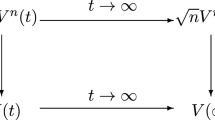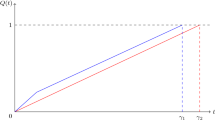Abstract
We consider the diffusion approximation of a G/Ph/n queue with customer abandonment in the Halfin–Whitt heavy-traffic regime and extend the conventional locally Lipschitz hazard-type scaling of abandonment time distribution to a more general scaling in the study. Under that new scaling of abandonment, not only the non-locally Lipschitz hazard-type case such as the non-locally bounded hazard-rate scaling which has never been solved to date, but also a wider range of abandonment time distributions including the non-absolutely continuous ones becomes subject to the analysis of diffusion approximation. Due to the general character of our scaling scheme of abandonment time, the stochastic equation for the limit of C-tight, scaled, and centered customer-count processes contains a nonlinear drift term as the limit of abandonment-count process, which does not satisfy the local Lipschitz condition so that the continuous mapping method in the literature of this area is invalid in our case. Instead, applying the Girsanov transformation to the localized multidimensional equation satisfied by the limit of customer-count process in multiphase of service time, we show the uniqueness in law of the solution to establish the desired diffusion approximation.
Similar content being viewed by others
References
Asmussen, S.: Applied Probability and Queues. Wiley, New York (1987)
Billingsley, P.: Convergence of Probability Measures. Wiley, New York (1968)
Brown, L., Gans, N., Mandelbaum, A., Sakov, A., Shen, H., Zeltyn, S., Zhao, L.: Statistical analysis of a telephone call center: a queueing-science perspective. J. Am. Stat. Assoc. 100, 36–50 (2005)
Dai, J.G., Dai, W.: A heavy traffic limit theorem for a class of open queueing networks with finite buffers. Queueing Syst. 32, 5–40 (1999)
Dai, J.G., He, S.: Customer abandonment in many-server queues. Math. Oper. Res. 35, 347–362 (2010)
Dai, J.G., He, S.: Queues in service systems: customer abandonment and diffusion approximations. Tutor. Oper. Res. 36–59 (2011)
Dai, J.G., He, S.: Many-server queues with customer abandonment: numerical analysis of their diffusion model. Stoch. Syst. 3, 96–146 (2013)
Dai, J.G., He, S., Tezcan, T.: Many-server diffusion limits for G/Ph/n+GI queues. Ann. Appl. Probab. 20, 1854–1890 (2010)
Gans, N., Koole, G., Mandelbaum, A.: Telephone call centers: tutorial, review, and research prospects. Manuf. Serv. Oper. Manag. 5, 79–141 (2003)
Garnett, O., Mandelbaum, A., Reiman, M.: Designing a call center with impatient customers. Manuf. Serv. Oper. Manag. 4, 208–227 (2002)
Halfin, S., Whitt, W.: Heavy-traffic limits for queues with many exponential servers. Oper. Res. 29, 567–588 (1981)
Huang, J., Zhang, H.: Diffusion approximations for open Jackson networks with reneging. Queueing Syst. 74, 445–476 (2013)
Huang, J., Zhang, H., Zhang, J.: Diffusion approximations for queueing systems with customer abandonment. arXiv:1208.5552 [math.PR] (2012)
Ikeda, N., Watanabe, S.: Stochastic Differential Equations and Diffusion Processes. North-Holland, Amsterdam (1981)
Jacod, J., Shiryaev, A.N.: Limit Theorems for Stochastic Processes. Springer, New York (1987)
Lee, C., Weerasinghe, A.: Convergence of a queueing system in heavy traffic with general patience-time distributions. Stoch. Process. Appl. 121, 2507–2552 (2011)
Mandelbaum, A., Momčilović, P.: Queues with many servers and impatient customers. Math. Oper. Res. 37, 41–65 (2012)
Puhalskii, A.A., Reiman, M.I.: The multiclass GI/PH/N queue in the Halfin-Whitt regime. Adv. Appl. Probab. 32, 564–595 (2000)
Reed, J.: The G/GI/N queue in the Halfin–Whitt regime. Ann. Appl. Probab. 19, 2211–2269 (2009)
Reed, J., Tezcan, T.: Hazard rate scaling of the abandonment distribution for the GI/M/n+GI queue in heavy traffic. Oper. Res. 60, 981–995 (2012)
Reed, J.E., Ward, A.R.: Approximating the GI/GI/1+GI queue with a nonlinear drift diffusion: hazard rate scaling in heavy traffic. Math. Oper. Res. 33, 606–644 (2008)
Revuz, D., Yor, M.: Continuous Martingales and Brownian Motion, 2nd edn. Springer, New York (1994)
Weerasinghe, A.: Diffusion approximations for G/M/n+GI queues with state-dependent service rates. Math. Oper. Res. 39, 207–228 (2013)
Yamada, K.: Two limit theorems for queueing systems around the convergence of stochastic integrals with respect to renewal processes. Stoch. Process. Appl. 80, 103–128 (1999)
Zeltyn, S., Mandelbaum, A.: Call centers with impatient customers: many-server asymptotics of the M/M/n+G queue. Queueing Syst. 51, 361–402 (2005)
Acknowledgments
The author would like to thank the anonymous referees and the associate editor for their careful readings and helpful comments on the submitted manuscript. The author would also like to thank Avi Mandelbaum and Junfei Huang for their interest and suggestion on a draft of the paper.
Author information
Authors and Affiliations
Corresponding author
Electronic supplementary material
Below is the link to the electronic supplementary material.
Appendix
Appendix
In this appendix, we put the following technical lemma that is used in the identification of the limit for the scaled abandonment-count processes, i.e., Lemma 2.7. It is a minor modification of Lemma 3.1 in Yamada [24] and also a generalization of Lemma 8.3 in Dai and Dai [4].
Lemma 4.1
Suppose that \(y^n(s), s\ge 0, n\in {{\mathcal {N}}},\) is a sequence of nondecreasing, right-continuous functions such that \(y^n(0)=0, n\in {{\mathcal {N}}},\) and \(y^n\) converges to \(y\) in \({\mathbb {D}}([0, \infty ), {{\mathcal {R}}}^1)\) as \(n\) tends to infinity, where \(y\) is a continuous function. Also assume that a sequence of functions \(f^n(s), s\ge 0, n\in {{\mathcal {N}}},\) is such that for each \(M>0\),
and for \(y(\mathrm{d}s)\)-a.e. \(s\),
as \(n\) tends to infinity. Moreover, suppose that there exists a sequence of step functions \(g_k(s), s\ge 0, k\in {{\mathcal {N}}},\) such that for each \(s\ge 0\),
as \(k\) tends to infinity. Then we have
as \(n\) tends to infinity, uniformly for \(t\) in any compact subset of \({{\mathcal {R}}}^1_+\).
\((\) A function \(g(s), s\ge 0,\) is said to be a step function if \(g(s)=c_i, s_{i-1}<s<s_{i},\) for some subdivision \(\{s_i \}\) of \([0, \infty ))\).
Rights and permissions
About this article
Cite this article
Katsuda, T. General hazard-type scaling of abandonment time distribution for a G/Ph/n+GI queue in the Halfin–Whitt heavy-traffic regime. Queueing Syst 80, 155–195 (2015). https://doi.org/10.1007/s11134-015-9434-1
Received:
Revised:
Published:
Issue Date:
DOI: https://doi.org/10.1007/s11134-015-9434-1
Keywords
- Diffusion approximation
- Many-server queue
- Halfin–Whitt heavy-traffic regime
- Scaling of abandonment time
- Phase-type service distribution
- Uniqueness in law
- Girsanov transformation




